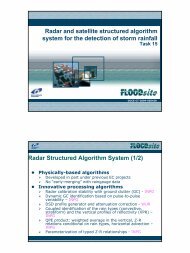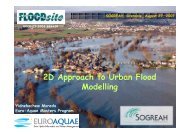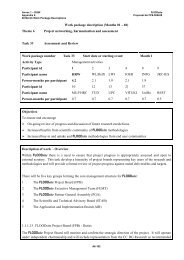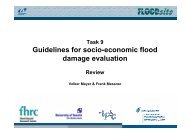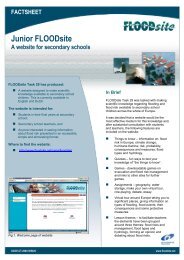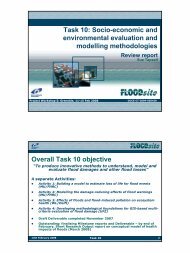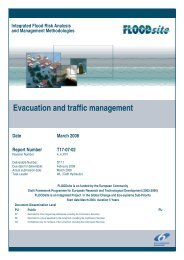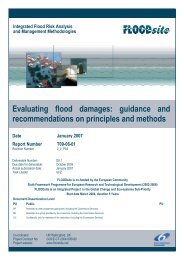Language of Risk - FLOODsite
Language of Risk - FLOODsite
Language of Risk - FLOODsite
Create successful ePaper yourself
Turn your PDF publications into a flip-book with our unique Google optimized e-Paper software.
<strong>FLOODsite</strong> <strong>Language</strong> <strong>of</strong> <strong>Risk</strong> 2 nd Ed.<br />
Contract No:GOCE-CT-2004-505420<br />
4.5 Consequence<br />
The direct effect <strong>of</strong> an event, incident or accident. It is expressed as a health effect (e.g., death, injury,<br />
exposure), property loss, environmental effect, evacuation, or quantity spilled.<br />
OHMS (2005)<br />
An impact such as economic, social or environmental damage/improvement that may result from a<br />
flood. May be expressed quantitatively (e.g. monetary value), by category (e.g. High, Medium, Low) or<br />
descriptively.<br />
HR Wallingford (2002)<br />
Exposure multiplied by vulnerability.<br />
Klijn (2004)<br />
Recommendation: An impact such as economic, social or environmental damage/improvement that<br />
may result from a flood. May be expressed quantitatively (e.g. monetary value), by category (e.g.<br />
High, Medium, Low) or descriptively.<br />
Rationale: OHMS (2005) is specific for hazardous materials, whilst Klijn (2004) encompasses terms<br />
that has the potential to be misinterpreted, in particular the term vulnerability. HR Wallingford (2002)<br />
is therefore preferred.<br />
4.6 Flood<br />
Temporary covering <strong>of</strong> land by water as a result <strong>of</strong> surface waters (still or flowing) escaping from<br />
their normal confines or as a result <strong>of</strong> heavy precipitation.<br />
(Munich Re - 1997)<br />
Flooding is a natural and recurring event for a river or stream. Statistically, streams will equal or<br />
exceed the mean annual flood once every 2.33 years.<br />
This definition is attributed to Leopold et al. in 1964, (http://www.higginslangley.org/definitions.html)<br />
but the original source is not given. However, this is just a statement <strong>of</strong> the frequency <strong>of</strong> occurrence<br />
<strong>of</strong> the mean <strong>of</strong> the annual maximum series <strong>of</strong> floods, using Generalised Extreme Value statistics.<br />
A temporary covering <strong>of</strong> land by water outside its normal confines (<strong>FLOODsite</strong> <strong>Language</strong> <strong>of</strong> risk first<br />
edition - 2005)<br />
The temporary covering by water <strong>of</strong> land not normally covered by water (European Directive on the<br />
assessment and management <strong>of</strong> floods (Directive 2007/60/EC)<br />
Recommendation: The temporary covering <strong>of</strong> land by water not normally covered by water<br />
Rationale: In general, flooding is associated with harm and damage and considered an undesirable<br />
occurrence, it is important to note this. The notion <strong>of</strong> the water having “normal confines” was taken to<br />
convey this notion in the first edition <strong>of</strong> the <strong>Language</strong> <strong>of</strong> <strong>Risk</strong>. Now we recommend the alternative<br />
phrase “not normally covered by water” as expressing the same sense and for consistency with the<br />
Floods Directive.<br />
4.7 Flood <strong>Risk</strong> Management<br />
A process <strong>of</strong> continuous analysis, adjustment and adaptation <strong>of</strong> a flooding system (including both<br />
structural and non-structural actions) taken to reduce flood risk.<br />
HR Wallingford (2007)<br />
Continuous and holistic societal analysis, assessment and mitigation <strong>of</strong> flood risk<br />
T32_04_01_ <strong>FLOODsite</strong>_<strong>Language</strong>_<strong>of</strong>_<strong>Risk</strong>_D32_2_v5_2_P1 30 April 2009<br />
16



